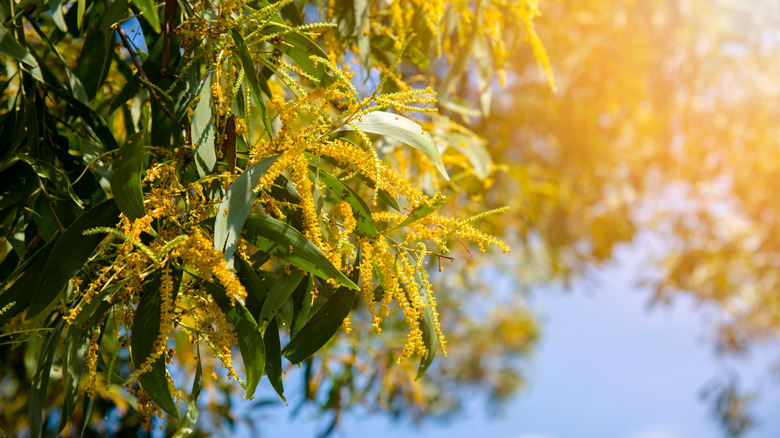The Invasive Species Of Acacia Tree To Avoid Planting In Your Yard At All Costs
Lovely pointed oval leaves, sprays of mimosa-like flowers, and eye-catching seed pods make the earleaf acacia (Acacia auriculiformis) a stunning tree. It's not hard to see why plant lovers introduced this southern hemisphere beauty to Florida gardens 100 years ago. Little did they know that these prolific trees would spread to the point of becoming a threat to other species. Earleaf acacias are yet another beautiful tree you should think twice about planting in your yard.
While just central and southern Florida have designated this tree as invasive, its sturdy characteristics could make it thrive in other parts of the country. What's more, earleaf acacia seeds are widely available for purchase online. It's made appearances in Puerto Rico and Hawaii as well. Earleaf acacias love moist, subtropical soils, but they also adapt well to dry conditions. Their resilience could make them a threat to drier regions as well. So, why are these trees causing harm, and what can you do about it?
Why are earleaf acacias a problem?
The exotic plant aficionados that brought earleaf acacias to Florida in the 1930s had a good feeling these trees would fare well in the state's subtropical climate. However, the South Pacific-native Acacia auriculiformis fits into Florida ecosystems a little too well. What was meant to be a novel ornamental tree is spreading faster than its few predators can keep up with. Earleaf acacias are both invasive plants and aggressive growers, a perfect combo for dominating an area and choking out native species.
Southern Florida is home to Everglades National Park, one of the country's most delicate and important wild spaces. It's the eastern U.S.'s largest designated wilderness, sheltering 13 endangered and 10 threatened species. As the western hemisphere's largest mangrove ecosystem, the Everglades are crucial feeding and breeding grounds for countless creatures. The U.S. Forest Service reports that nearly half of the country's endangered and threatened species have declining populations because of invasive plants, and nearly 20% of endangered and threatened species are at risk primarily due to invasive plants.
How can you help stop the spread of earleaf acacia?
First, prevention is key. Don't plant these trees in any area, especially in ones that are part of USDA zones 10a to 11 (where earleaf acacias are hardy). Despite their availability for purchase, steer clear of these seeds. Just by being around these trees, you might be unknowingly contributing to their spread. A single earleaf acacia can crank out nearly 50,000 seeds per year. It's mainly birds that disperse the seeds, but they can hitch rides on people and pets as well. The U.S. Forest Service advises you to check your clothing, animals' fur, and your vehicles for seeds before leaving an area where invasive plants are known to grow.
Second, If you have these tenacious trees on your property, it's wise to get rid of them as soon as possible. Check out our guide on everything you need to know to cut down trees in your yard. In addition to getting rid of the tree, remove the root system and seedlings and destroy any seeds. The University of Florida's Center for Aquatic and Invasive Plants suggests replacing the tree with native mastic (Masichodendron foetidissimum) or Florida soapberry (Sapindus saponaria) instead.


